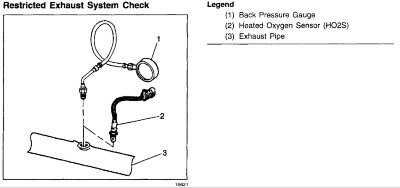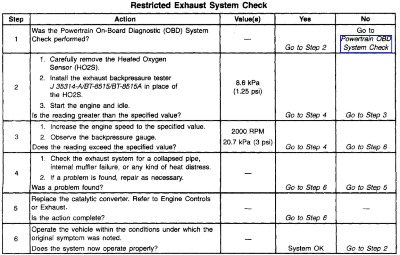TahoeInFC
Member
Hey All,
Man, this is a good forum for folks like us trying to keep these OBS trucks on the road.
Recently, my truck (99 Tahoe, 5.7L, 132k miles on the counter) threw the dreaded P0430 code for a catalyst inefficiency, and I've been hunting around out here for help. I've found a ton of help in this forum, and have taken some actions according to previous advice given. (SunlitComet, I've especially appreciated your technical posts...they have helped me determine a troubleshooting direction on more than just this occasion)
I'll tell you what I've done and what I've learned, and hoping you smart folks can tell me if I'm on the right track.
I'm going to apologize in advance for the long post, but I've noticed that many OP's don't post enough info to get a diagnosis started, so I wanted to make sure you had all the details.
My truck originally threw the P0430 code about 6 months ago. I read it and cleared it to see if it would return. It didn't return until just a couple weeks ago, so I thought that first code may have been a hiccup due to bad gas, etc... So I reset the code again. No such luck this time...it came back again. Rinse, repeat, and the code returns. I guess it's time to dig in and fix it.
My first action was to read the O2 sensors with a scanner. I got the truck warmed up by driving around for 20 minutes or so, then sat in my driveway, revved to about 2000-2500 RPM and watched the sensor voltages.
Under these conditions, both upstream sensors seem to be cycling through the range of about 0.2V to about 0.8V, so appears to be going closed loop. At the time of this first reading, the downstream on bank 1 was sitting somewhere mid-range between 0.4V to 0.7V, but downstream on bank 2 was around 0.2-0.3V and just sitting there. When I backed off the throttle and let it idle, the downstream sensors started moving around more. The bank 2 downstream is capable of going to higher voltages than just 0.2V and is erratic during idle, seemingly tracking the upstream (sort of). It just drops low when the RPMs are increased. I'm thinking this is probably trimming the engine to the rich side, and is probably because of a plugged cat.
When I took this same reading today, both downstream sensors seem to be behaving this way, so I think both cats need to be changed.
All four O2 sensors were replaced about 20k miles ago, but don't know the brand. The previous owner kept the records, but I don't know if he used OEM sensors. I'm guessing he did because he kept this truck immaculate and tended to use genuine GM parts according to most of the service records he gave me.
My next action was to pull some plugs and check them out. I pulled both rear plugs, and both are fairly clean, but perhaps a little sooty down in the 'wells' of the plug. The spark elements are clean and bronze, and definitely not fouled or wet with fuel. The two front plugs look great. No white or black residue. Clean burn plugs, and no obvious issues.
The tailpipe has a very slight black soot inside, so I know it's running rich, at least at times. It runs rich at start-up for sure. My wife fired it up this morning, and it burned my eyes for a few minutes...whew! Sulfur and fuel for certain. It's not as bad after running for awhile, but still annoyingly stinky. Another sign of failing cats, or so I've read.
This truck has the improved fuel injection spider, and had some fuel metering work done just before I bought it. It runs well, but I can sometimes feel a slight miss and rough idle...not always. I'm starting to question my fuel pump, because I don't think it's ever been changed, but that's a different topic for a different thread.
So, for you experts, do you think I'm on the right track for new cats?
Do I have underlying issues that are failing the existing converters? Or are my failing cats causing issues that are affecting the engine fuel trim? Sort of a 'chicken and the egg' question, I know.
Bad O2 sensors? Usually the sensors last a long time, much more than 20k miles.
If I need new converters, I'm planning to use the direct-fit Walker cats. The are reasonably priced and for all the reading I've done, people seem generally happy. I've also read in various places that Walker supplies GM with OEM cats, so I can't be too far off the mark here. I'm not interested in 'performance cats'
Also, before anyone tells me to just "cut 'em off", I'm in an emissions area in Colorado. I wish I could just take them off, but I don't have that option. I'm not really interested in cheater pipes for the 364 days I don't need cats.
Your thoughts?
Thanks!
Man, this is a good forum for folks like us trying to keep these OBS trucks on the road.
Recently, my truck (99 Tahoe, 5.7L, 132k miles on the counter) threw the dreaded P0430 code for a catalyst inefficiency, and I've been hunting around out here for help. I've found a ton of help in this forum, and have taken some actions according to previous advice given. (SunlitComet, I've especially appreciated your technical posts...they have helped me determine a troubleshooting direction on more than just this occasion)
I'll tell you what I've done and what I've learned, and hoping you smart folks can tell me if I'm on the right track.
I'm going to apologize in advance for the long post, but I've noticed that many OP's don't post enough info to get a diagnosis started, so I wanted to make sure you had all the details.
My truck originally threw the P0430 code about 6 months ago. I read it and cleared it to see if it would return. It didn't return until just a couple weeks ago, so I thought that first code may have been a hiccup due to bad gas, etc... So I reset the code again. No such luck this time...it came back again. Rinse, repeat, and the code returns. I guess it's time to dig in and fix it.
My first action was to read the O2 sensors with a scanner. I got the truck warmed up by driving around for 20 minutes or so, then sat in my driveway, revved to about 2000-2500 RPM and watched the sensor voltages.
Under these conditions, both upstream sensors seem to be cycling through the range of about 0.2V to about 0.8V, so appears to be going closed loop. At the time of this first reading, the downstream on bank 1 was sitting somewhere mid-range between 0.4V to 0.7V, but downstream on bank 2 was around 0.2-0.3V and just sitting there. When I backed off the throttle and let it idle, the downstream sensors started moving around more. The bank 2 downstream is capable of going to higher voltages than just 0.2V and is erratic during idle, seemingly tracking the upstream (sort of). It just drops low when the RPMs are increased. I'm thinking this is probably trimming the engine to the rich side, and is probably because of a plugged cat.
When I took this same reading today, both downstream sensors seem to be behaving this way, so I think both cats need to be changed.
All four O2 sensors were replaced about 20k miles ago, but don't know the brand. The previous owner kept the records, but I don't know if he used OEM sensors. I'm guessing he did because he kept this truck immaculate and tended to use genuine GM parts according to most of the service records he gave me.
My next action was to pull some plugs and check them out. I pulled both rear plugs, and both are fairly clean, but perhaps a little sooty down in the 'wells' of the plug. The spark elements are clean and bronze, and definitely not fouled or wet with fuel. The two front plugs look great. No white or black residue. Clean burn plugs, and no obvious issues.
The tailpipe has a very slight black soot inside, so I know it's running rich, at least at times. It runs rich at start-up for sure. My wife fired it up this morning, and it burned my eyes for a few minutes...whew! Sulfur and fuel for certain. It's not as bad after running for awhile, but still annoyingly stinky. Another sign of failing cats, or so I've read.
This truck has the improved fuel injection spider, and had some fuel metering work done just before I bought it. It runs well, but I can sometimes feel a slight miss and rough idle...not always. I'm starting to question my fuel pump, because I don't think it's ever been changed, but that's a different topic for a different thread.
So, for you experts, do you think I'm on the right track for new cats?
Do I have underlying issues that are failing the existing converters? Or are my failing cats causing issues that are affecting the engine fuel trim? Sort of a 'chicken and the egg' question, I know.
Bad O2 sensors? Usually the sensors last a long time, much more than 20k miles.
If I need new converters, I'm planning to use the direct-fit Walker cats. The are reasonably priced and for all the reading I've done, people seem generally happy. I've also read in various places that Walker supplies GM with OEM cats, so I can't be too far off the mark here. I'm not interested in 'performance cats'
Also, before anyone tells me to just "cut 'em off", I'm in an emissions area in Colorado. I wish I could just take them off, but I don't have that option. I'm not really interested in cheater pipes for the 364 days I don't need cats.
Your thoughts?
Thanks!


